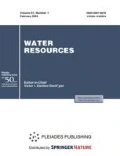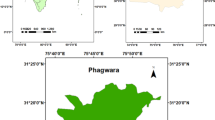Abstract
Quantification of infiltration characteristics of soil is a complex problem because of its variability, selection of suitable infiltration model, and determination of infiltration model parameters which depend on various soil characteristics and land uses. In this study four different infiltration models, namely, Horton, Kostiakov, Modified Kostiakov and Philip were considered. Infiltration experiments, using double-ring infiltrometer, were conducted to measure infiltration rate (f) on three different land covers viz. farmland, built-up and shrubland under the soil textures of clay and sandy clay in an urban sub-basin of lesser Himalayas, India. Predictability of infiltration models for different land covers under given soil textures was assessed by comparing field measured and model-predicted f. The performance of different infiltration models was assessed by computing different statistical indicators, and an overall performance index (OPI) was computed to rank the models. The Horton model was found to be the most suitable infiltration model with highest OPI values of 0.94 for different land covers under the soils of clay and sandy clay texture followed by Philip model. The results of this study will be useful for selecting suitable infiltration model for estimating infiltration rate in water balance modelling, and planning and management of water resources in the study area.





Similar content being viewed by others
REFERENCES
Ali, S., Islam, A., Mishra, P.K. and Sikka, A.K., Green-Ampt approximations: A comprehensive analysis, J. Hydrol., 2016, vol. 535, pp. 340–355.
Badar, B., Romshoo, S.A., and Khan, M.A., Modelling catchment hydrological responses in a Himalayan Lake as a function of changing land use and land cover, J. Earth Syst. Sci., 2013, vol. 122, pp. 433–449.
Blacke, G.R. and Hartge, K.H., Bulk density, in Methods of soil analysis. Part1. Physical and Mineralogical Methods, Klute, A., Ed., Soil Science Society of America, Madison, WI, 1986, 2nd ed, pp. 363–375.
Blacke, G.R. and Hartge, K.H., Particle density, in Methods of soil analysis. Part1. Physical and Mineralogical Methods, Klute, A., Ed., Soil Science Society of America, Madison, WI, 1986, pp. 377–382.
Dagadu, J.S. and Nimbalkar, P.T., Infiltration studies of different soils under different soil conditions and comparison of infiltration models with field data, Int. J. Adv. Eng. Technol., 2012, vol. 3, no. 2, pp. 154–157.
Dashtaki, S.G., Homaee, M., Mahdian, M.H., and Kouchakzadeh, M., Site-dependence performance of infiltration models, Water Resour. Manage., 2009, vol. 23, no.13, pp. 2777–2790.
Deep, K. and Das, K.N., Optimization of infiltration parameters in hydrology, World J. Model. Simul., 2008, vol. 4, no. 2, pp. 120–130.
Dingman, S.L., Physical Hydrology, Waveland press, 2015.
Duan, R., Fedler, C.B., and Borrelli, J., Field evaluation of infiltration models in lawn soils, Irrigation Sci., 2011, vol. 29, no.5, pp. 379–389.
Duffera, M., White, J.G., and Weisz, R., Spatial variability of Southeastern US Coastal Plain soil physical properties: Implications for site-specific management, Geoderma, 2007, vol. 137, nos. 3–4, pp. 327–339.
Gee, G.W. and Bauder, J.W., Particle-size analysis, in Methods of Soil Analysis. Part1. Physical and Mineralogical Methods, Klute, A., Ed., Soil Science Society of America, Madison, WI, 1986, pp. 383–412.
Green, W.H. and Ampt, G.A., Studies on Soil Physics, J. Agric. Sci., 1911, vol. 4, no. 1, pp. 1–24.
Grinevskii, S.O. and Novoselova, M.V., Regularities in the formation of groundwater infiltration recharge, Water Resour., 2011, vol. 38, no. 2, pp. 175–186.
Grinevskii, S.O. and Pozdnyakov, S.P., Principles of regional estimation of infiltration groundwater recharge based on geohydrological models, Water Resour., 2010, vol. 37, no. 5, 638–652.
Gupta, H.V., Sorooshian, S., and Yapo, P.O., Status of automatic calibration for hydrologic models: Comparison with multilevel expert calibration, J. Hydrol. Eng., 1999, vol. 4, no. 2, pp. 135–143.
Holtan, H.N., Concept for infiltration estimates in watershed engineering, 1961.
Horton, R.E., An approach toward a physical interpretation of infiltration-capacity 1, Soil Sci. Soc. Am. J., 1941, vol. 5, no. C, pp. 399–417.
Kostiakov, A.N., On the dynamics of the coefficient of water-percolation in soils and on the necessity for studying it from a dynamic point of view for purposes of amelioration, In Transactions Congress International Society for Soil Science, 6th, Moscow, Part A, 1932, pp. 17–21.
Machiwal, D., Jha, M.K., and Mal, B.C., Modelling infiltration and quantifying spatial soil variability in a wasteland of Kharagpur, India, Biosyst. Eng., 2006, vol. 95, no. 4, pp. 569–582.
Marquardt, D.W., An algorithm for least-squares estimation of nonlinear parameters, J. Soc. Ind. Appl. Math., 1963, vol. 11, no. 2, pp. 431–441.
Mazloom, H. and Foladmand, H., Evaluation and determination of the coefficients of infiltration models in Marvdasht region, Fars province, Int. J. Adv. Biol. Biomed. Res., 2013, vol. 1, no. 8, pp. 822–829.
Mishra, S.K., Tyagi, J.V., and Singh, V.P., Comparison of infiltration models, Hydrol. Process, 2003, vol. 17, no. 13, pp. 2629–2652.
Nash, J.E. and Sutcliffe J.V., River flow forecasting through conceptual models part I–A discussion of principles, J. Hydrol, 1970, vol. 10, no. 3, pp. 282–290.
Nielsen, D.R. and Bouma, J., Soil Spatial Variability: Proceedings of a Workshop of the ISSS and the SSSA, Las Vegas, USA/Pdc296. Center Agricultural Pub and Document, Pudoc Wageningen, the Netherlands, 1985.
Philip, J.R., The theory of infiltration: 1 The infiltration equation and its solution, Soil. Sci., 1957, vol. 83, no. 5, pp. 345–358.
Richard, L.A., Capillary conduction of liquids through porous mediums, Physics, 1931, vol. 1, no. 5, pp. 318–333.
Skaggs, R.W. and Khaleel, R., Chapter 4: Infiltration. American Society of Agricultural Engineers Monograph Hydrologic Modeling of Small Watersheds, Haan, C.T., Ed, 1982.
Smith, R.E., The infiltration envelope: results from a theoretical infiltrometer, J. Hydrol., vol. 17, nos. 1–2, pp. 1–22. https://doi.org/10.1016/0022-1694(72)90063-7
Smith, R.E. and Parlange, J.Y., A parameter-efficient hydrologic infiltration model, Water. Resour. Res., 1978, vol. 14, no. 3, pp. 533–538.
SPSS, I., SPSS for Mac, Release 20.0. Chicago: SPSS Inc, 2011.
Vasu, D., Singh, S.K., Tiwary, P., Chandran, P., Ray, S.K. and Duraisami, V.P., Pedogenic processes and soil–landform relationships for identification of yield-limiting soil properties, Soil. Res., 2017, vol. 55, no. 3, pp. 273–284.
Walkley, A. and Black, I.A., An examination of the Degtjareff method for determining soil organic matter, and a proposed modification of the chromic acid titration method, Soil. Sci., 1934, vol. 37, no. 1, pp. 29–38.
Wang, Y.Q. and Shao, M.A., Spatial variability of soil physical properties in a region of the Loess Plateau of PR China subject to wind and water erosion, Land. Degrad. Dev., 2013, vol. 24, no. 3, pp. 296–304.
Willmott, C.J., On the validation of models, Phys Geogr., 1981, vol. 2, no. 2, pp. 184–194.
Wilson, R.L., Comparing Infiltration Models to Estimate Infiltration Potential at Henry V Events, 2017.
Zhang, C., Yan, H., Takase, K., and Oue, H., Comparison of the soil physical properties and hydrological processes in two different forest type catchments, Water Resour., 2016, vol. 43, no. 1, pp. 225–237.
Zolfaghari, A.A., Mirzaee, S., and Gorji, M., Comparison of different models for estimating cumulative infiltration, Int. J. Soil. Sci., 2012, vol. 7, no. 3, pp. 108–115.
ACKNOWLEDGMENTS
The authors are grateful to the Head of Department, Civil Engineering, National Institute of Technology Srinagar for providing adequate laboratory facilities.
Funding
This research received no specific grant from any funding agency in the public, commercial, or not-for-profit sectors.
Author information
Authors and Affiliations
Corresponding author
Ethics declarations
The authors state that they have no conflict of interest.
Rights and permissions
About this article
Cite this article
Rasool, T., Dar, A.Q. & Wani, M.A. Comparative Evaluation of Infiltration Models under Different Land Covers. Water Resour 48, 624–634 (2021). https://doi.org/10.1134/S0097807821040175
Received:
Revised:
Accepted:
Published:
Issue Date:
DOI: https://doi.org/10.1134/S0097807821040175




